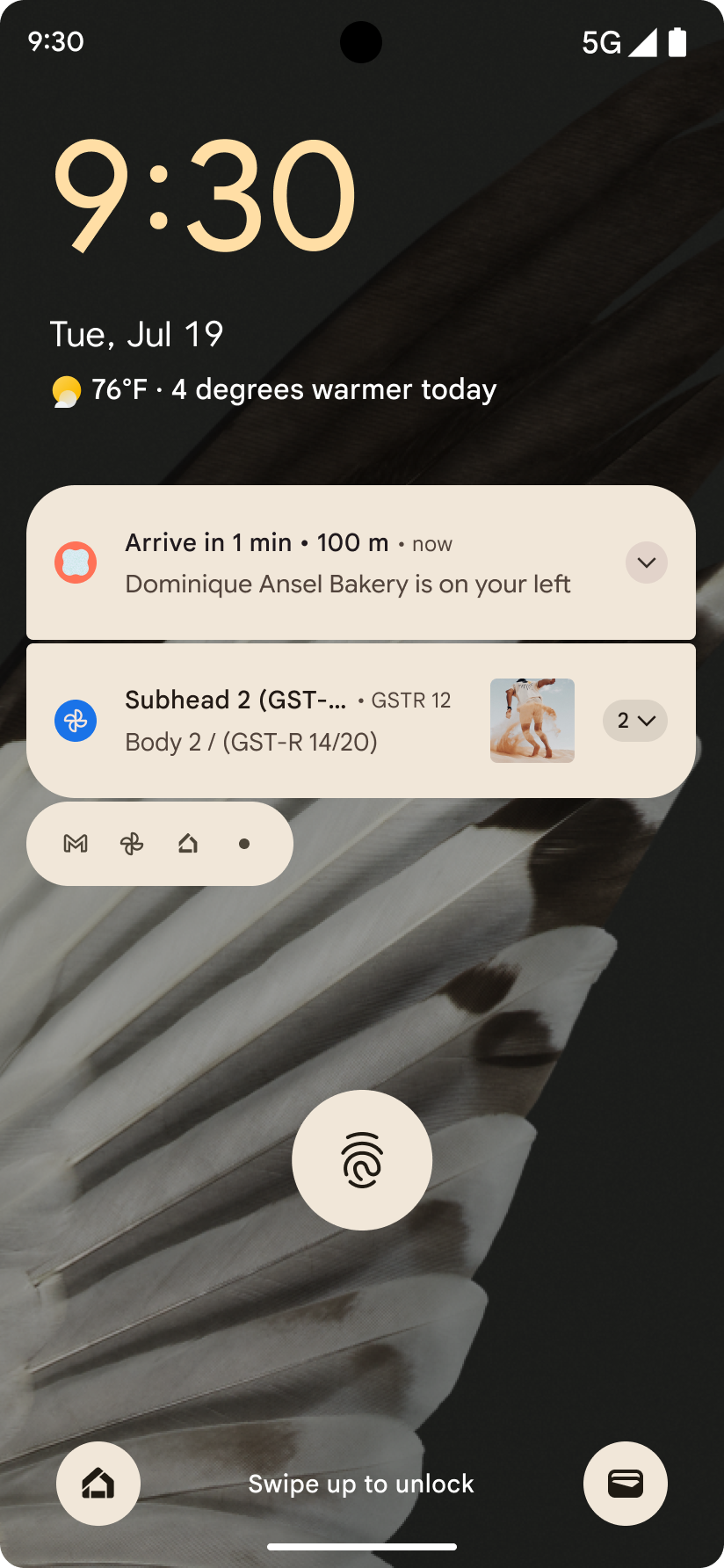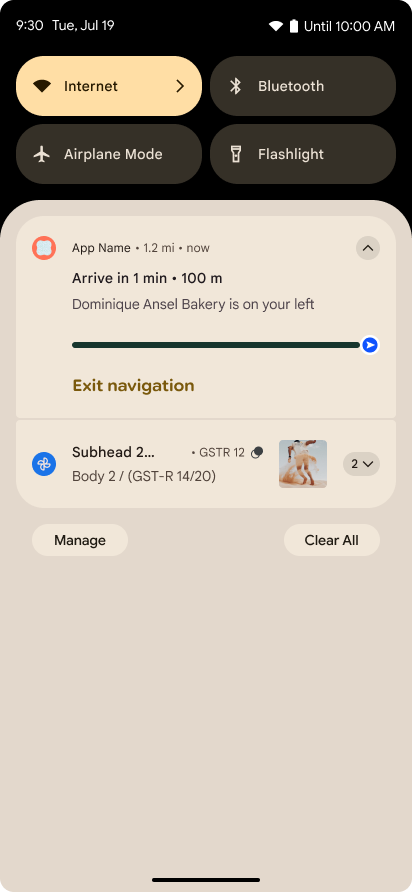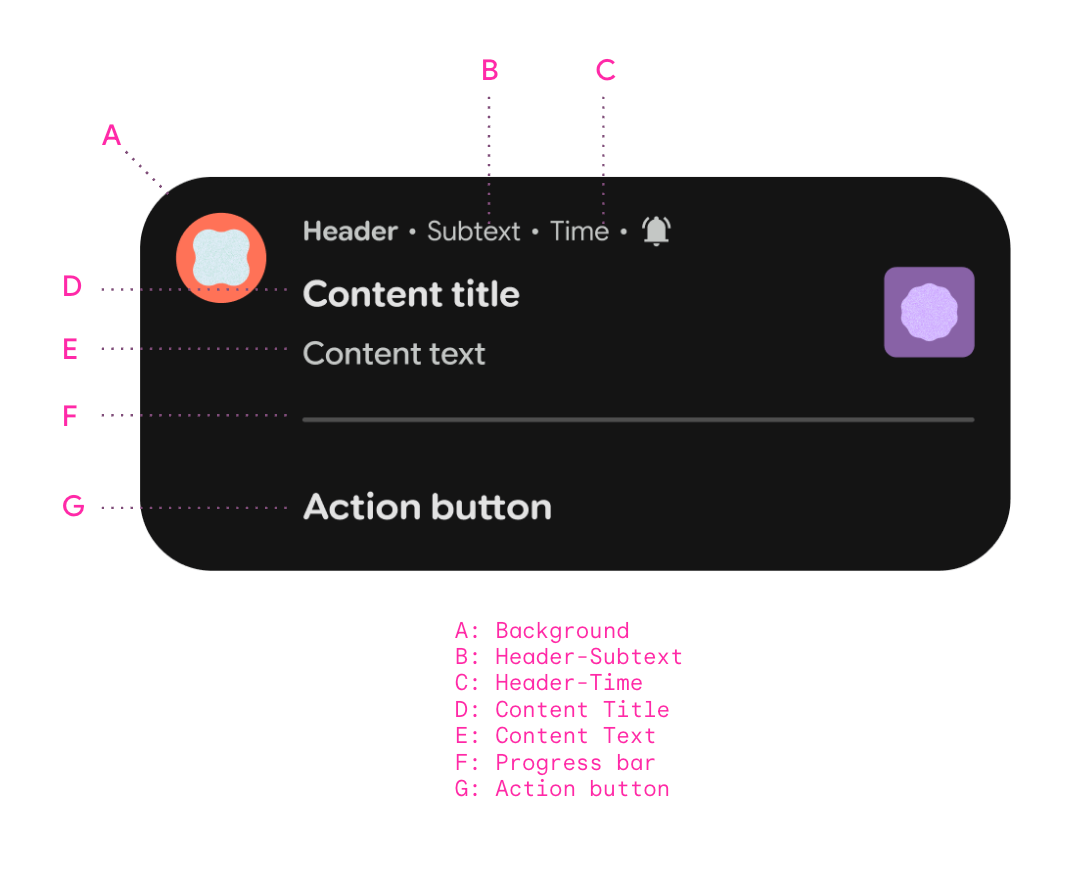Android 16 presenta notificaciones centradas en el progreso para ayudar a los usuarios a hacer un seguimiento sin problemas de los recorridos de principio a fin que inician.
Notification.ProgressStyle es un nuevo estilo de notificación que te permite crear notificaciones centradas en el progreso. Entre los casos de uso clave, se incluyen el transporte privado con conductor, la entrega y la navegación. Dentro de la clase Notification.ProgressStyle, puedes denotar estados y eventos importantes en el recorrido del usuario con
puntos y segmentos.


Clases y métodos relevantes
Las siguientes clases contienen las diferentes APIs que usas para crear una
notificación de ProgressStyle:
Anatomía y personalización
En las siguientes imágenes, se muestran las diferentes partes que conforman las notificaciones de ProgressStyle:
En las siguientes imágenes, se muestran las diferentes partes que conforman las notificaciones de ProgressStyle:

A. Encabezado: Subtítulo |
|
B. Encabezado: Tiempo |
|
C. Título del contenido |
|
D. Texto del contenido |
|
E. Barra de progreso |
|
F. Botón de acción |

Prácticas recomendadas
Sigue estas prácticas recomendadas para proporcionar la mejor experiencia del usuario posible con notificaciones centradas en el progreso:
- Asegúrate de que los campos correctos estén configurados para cumplir con la visibilidad de anuncios promocionados.
- Usa los elementos visuales adecuados para guiar al usuario en su recorrido. Por ejemplo, las apps de transporte privado con conductor deben establecer una imagen del vehículo y el color más preciso del vehículo que se usa en una experiencia de transporte privado con conductor con
Notification.setLargeIcon(). - Usa un lenguaje conciso y claro para definir el progreso de ese recorrido del usuario. La hora de llegada, el nombre del conductor y el estado del viaje son textos fundamentales que se deben comunicar en la notificación.
- Proporciona acciones útiles y relevantes en la notificación que ayuden a optimizar el recorrido del usuario. Por ejemplo, proporcionar una propina o agregar un plato adicional a un pedido de entrega de comida iniciado recientemente son acciones que se pueden realizar antes de la entrega.
- Usa segmentos y puntos para indicar estados. Por ejemplo, usa segmentos para colorear un estado y la duración del tráfico en un viaje de transporte privado con conductor, y usa puntos para los estados de eventos importantes, preparación de alimentos, entrega y partida de pasajeros.
- Actualiza la experiencia de progreso con frecuencia y precisión para que coincida con el progreso real del viaje. Por ejemplo, las condiciones de tráfico que cambian pueden reflejarse en cambios en los colores de los segmentos y en las actualizaciones de texto.
En el siguiente fragmento de código, se muestra cómo se podría usar una notificación ProgressStyle para un contexto de viaje compartido:
var ps =
Notification.ProgressStyle()
.setStyledByProgress(false)
.setProgress(456)
.setProgressTrackerIcon(Icon.createWithResource(appContext, R.drawable.ic_car_red))
.setProgressSegments(
listOf(
Notification.ProgressStyle.Segment(41).setColor(Color.BLACK),
Notification.ProgressStyle.Segment(552).setColor(Color.YELLOW),
Notification.ProgressStyle.Segment(253).setColor(Color.WHITE),
Notification.ProgressStyle.Segment(94).setColor(Color.BLUE)
)
)
.setProgressPoints(
listOf(
Notification.ProgressStyle.Point(60).setColor(Color.RED),
Notification.ProgressStyle.Point(560).setColor(Color.GREEN)
)
)
Ten en cuenta que, en el ejemplo, se establece una imagen de vehículo para el ícono del dispositivo de rastreo, y se usan segmentos y puntos para indicar la experiencia de viaje compartido y los eventos importantes para brindar una experiencia del usuario más completa.
Consulta la app de ejemplo para obtener más información.

